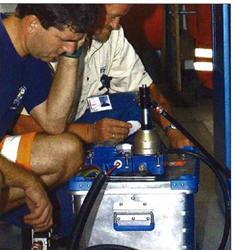As a physicist, I am always in awe of the massive particle accelerators used to probe the fundamental nature of matter and energy. The technological achievements required to build and operate these machines are as impressive to me as the physics discoveries they enable.
So I was fascinated to learn about the recent cabling developments that helped enable the startup of CERN's Large Hadron Collider (LHC), the world's largest and most powerful particle accelerator. As spectacular as the physics is, we should not overlook the equally spectacular engineering that makes it possible.
The 27-km LHC accelerator ring sits 100 meters underground, straddling the border between Switzerland and France. When operating at full power, trillions of protons will race around the LHC tunnel at 99.9% the speed of light, guided by powerful superconducting magnets and smashed together inside four huge particle detectors.
The collisions will generate exploding fireballs of subatomic debris that could reveal new fundamental particles and forces that shape our universe. But first, tens of thousands of sensors and control systems must work together to monitor beam stability, provide collision triggers, and more - requiring an extensive optical communications network unlike any other.
Laying 1500 km of
fiber optic cables around a tunnel 100
meters underground was an epic cabling
challenge. Fortunately, scientists at CERN
found an innovative partner for the job in
Netherlands-based Draka Comteq Telecom.
Their patented microduct blown fiber
solution provided the flexibility, radiation
resilience, and long cable lengths needed
for this unprecedented undertaking.
Need for Speed
A key requirement was the ability to rapidly install fiber links over long single-blow distances. The LHC tunnel is separated into eight 3.4 km octant sections connected by access shafts.
Being able to blow 3.4+ km cable lengths in one go avoided the need for time-consuming mid-tunnel splicing. Draka's experts developed and patented a novel cable lubrication system to reduce friction. As the fiber exits the pneumatic blowing equipment, it passes through lubricant-filled foam plugs that coat the cable surface. This allowed a 24 fiber cable in a 7/5.5 mm microduct to be blown an astonishing 3,474 meters in one nonstop run - a new world record!
 |
 |
Figure 1. Optical fibre blowing in the LHC tunnel
Coping with Radiation
Particle accelerators are extremely radioactive environments. Stray particles can degrade fiber performance over time, eventually requiring damaged links to be replaced. Draka's microduct approach allows individual cables to be rapidly blown out and substituted without taking critical systems offline.There were concerns radiation could embrittle the microducts themselves. But Draka confirmed excellent blowing performance even after microduct and fiber samples were irradiated to 300 kGy - simulating over 20 years of LHC operation. This ensures the infrastructure can reliably support the facility over its multi-decade service life.
Big Physics, Big Data
When experiments are running, the LHC
will generate up to 1 terabyte per second of
data from its suite of massive particle
detectors - similar to Europe's entire
telecommunications traffic. Gathering,
processing and analyzing this firehose of
information is a data science challenge as
monumental as the physics challenge itself.
The LHC computing infrastructure spans
over 170 data centers in 42 countries,
comprising over 200,000 processors. This
distributed "grid" analyzes LHC data and
distributes simulation and modeling tools to
over 8,000 physicists worldwide. keeping it
all connected is a complex 100 petabyte
fiber optic network infrastructure linking
CERN to 11 major computer "Tier 1" sites at
universities and labs across Europe and
America. Innovations like Draka's
extreme long haul fiber solutions will play
an essential role transporting torrents of
precious discovery data out of CERN and into
the hands of physicists everywhere, enabling
international collaborations that promise to
reshape our fundamental understanding of
nature's laws.
Conclusion
Particle physics experiments are at the very forefront of science - but could not happen without equivalent feats of engineering pushing technology to the limits. As the LHC gears up for a new run that promises discoveries which could radically revise physics textbooks, we applaud the physicists revealing nature's secrets as well as the engineers making those revelations possible in the first place. Both communities demonstrate incredible determination advancing the frontiers of human knowledge.
References
-
FibreSystems Europe/LIGHTWAVE Europe “ Fibers.org ”,
Anything missing? Write it here